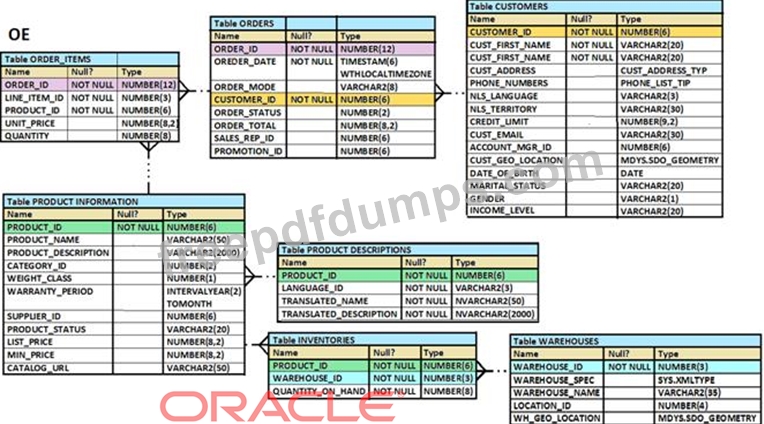1z1-071 Exam Question 121
View the Exhibit and examine the structure of the PRODUCT_INFORMATION table.

PRODUCT_ID column is the primary key.
You create an index using this command:
SQL > CREATE INDEX upper_name_idx
ON product_information(UPPER(product_name));
No other indexes exist on the PRODUCT_INFORMATION table.
Which query would use the UPPER_NAME_IDX index? (Choose the best answer.)

PRODUCT_ID column is the primary key.
You create an index using this command:
SQL > CREATE INDEX upper_name_idx
ON product_information(UPPER(product_name));
No other indexes exist on the PRODUCT_INFORMATION table.
Which query would use the UPPER_NAME_IDX index? (Choose the best answer.)
1z1-071 Exam Question 122
Which three statements execute successfully?
A)

B)

C)

D)

E)

F)

G)

A)

B)

C)

D)

E)

F)

G)

1z1-071 Exam Question 123
View the Exhibit and examine the structure of ORDERS and ORDER_ITEMS tables.
ORDER_ID is the primary key in the ORDERS table and the foreign key of the ORDER_ITEMS table, whose constraint is defined with the ON DELETE CASCADE option.
Which DELETE statement would execute successfully?

ORDER_ID is the primary key in the ORDERS table and the foreign key of the ORDER_ITEMS table, whose constraint is defined with the ON DELETE CASCADE option.
Which DELETE statement would execute successfully?

1z1-071 Exam Question 124
Examine this query:
SELECT TRUNC(ROUND(156.00, -2), -1) FROM DUAL;
What is the result?
SELECT TRUNC(ROUND(156.00, -2), -1) FROM DUAL;
What is the result?
1z1-071 Exam Question 125
Examine the description of the TRANSACTIONStable:

Which two SQL statements execute successfully?
SELECT customer_id AS "CUSTOMER-ID", transaction_date AS DATE, amount + 100

Which two SQL statements execute successfully?
SELECT customer_id AS "CUSTOMER-ID", transaction_date AS DATE, amount + 100

